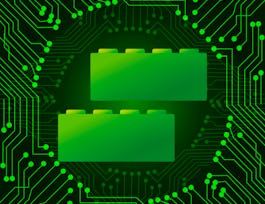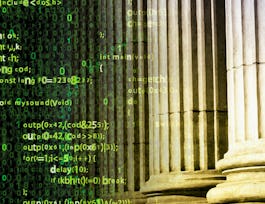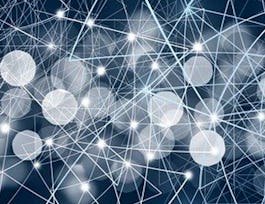This course will guide you through fundamental concepts and skills to confidently navigate various aspects of IT and the digital world. You will be introduced to the vast field of IT, covering a wide range of topics to build your IT knowledge. You will delve into hardware, operating systems technology, software, programming, databases, networking, storage, cybersecurity, cloud computing, and support and operations.



Information Technology (IT) Fundamentals for Everyone
This course is part of multiple programs.

Instructor: IBM Skills Network Team
Sponsored by Connors State College
14,501 already enrolled
(152 reviews)
Recommended experience
What you'll learn
Define operating systems, computer components, programming concepts, databases, and explain the differences between commercial and open software
Summarize the importance of computer networks, including wired and wireless connections; explore network resources and storage types in MS Windows
Describe how to protect against security threats, address public browsing security concerns, and list password management best practices
List the benefits of cloud computing, describe the cloud infrastructure layer, virtual machines, and summarize features of ticketing systems
Details to know

Add to your LinkedIn profile
18 assignments
See how employees at top companies are mastering in-demand skills

Build your subject-matter expertise
- Learn new concepts from industry experts
- Gain a foundational understanding of a subject or tool
- Develop job-relevant skills with hands-on projects
- Earn a shareable career certificate from IBM


Earn a career certificate
Add this credential to your LinkedIn profile, resume, or CV
Share it on social media and in your performance review

There are 6 modules in this course
This week you will learn about computer hardware and operating systems. Lesson one presents computing fundamentals such as types of devices, their benefits, their internal components, and peripheral devices. Other hardware you will learn about includes printers, display devices, and port types, along with their connectors. In lesson two, you will be introduced to operating systems for the devices you learned about in lesson one. You will learn how those operating systems implement files and folders and the basic operations you can perform on them.
What's included
11 videos3 readings3 assignments1 app item4 plugins
This module has three lessons that cover the basics of software, web browsers, programming languages, and database fundamentals. The first lesson addresses software applications, where you learn about the differences between open-source and commercial software, software versioning, file formats, and components of web browsers. In the second lesson, you will explore some basic programming concepts. In the third lesson, you investigate databases, where you compare and contrast different types of database storage and manipulation.
What's included
12 videos3 readings4 assignments2 app items6 plugins
In this two-lesson module, you learn about networking and storage. Lesson one focuses on networking, where you investigate concepts such as comparing and contrasting types of networks’ topologies, the cables used to connect devices to a network, and the common ports those cables use. You learn about network connections and how to adjust network settings in Windows. In lesson two, you are presented with types of local storage devices compared to hosted storage and sharing and how to troubleshoot storage issues.
What's included
10 videos2 readings3 assignments2 app items3 plugins
In the two instructional lessons in this module, you will be introduced to some fundamental concepts in cybersecurity. First, you hear about the confidentiality, integrity, and availability triad and then about intellectual property and confidential information. Then you will learn about types of threats, breaches, and attacks. You will explore password management, access control, authorization, and single-sign-on authentication. In lesson two, you will learn about safe browsing practices such as application ecosystem security, plug-ins, extensions, and toolbars. You will also learn about public browsing risks, safe browsing techniques, and virtual private networks.
What's included
11 videos2 readings3 assignments1 app item5 plugins
Cloud computing is the topic of this module. In lesson one, explore the characteristics, benefits, models, infrastructure, virtualization, and storage for cloud-native applications. In lesson two, you learn about cloud-computing emerging trends and practices. Some of those trends include the hybrid-multi-cloud, containerization, microservices architecture, serverless computing, and the development of applications specifically for the cloud, also known as cloud-native applications.
What's included
12 videos2 readings3 assignments1 app item5 plugins
In the first lesson of this module, you will test your knowledge and the skills you’ve acquired in this course. This module contains a 20-question graded final examination focused on the content of this course. In lesson two, you may choose to learn about troubleshooting and ticketing systems. This is not a required lesson for this course, but the content will provide you with an overview of troubleshooting and ticketing systems, enhancing your knowledge of IT Fundamental concepts.
What's included
5 videos3 readings2 assignments2 plugins
Instructor

Offered by
Why people choose Coursera for their career




Learner reviews
Showing 3 of 152
152 reviews
- 5 stars
81.81%
- 4 stars
12.33%
- 3 stars
1.29%
- 2 stars
1.94%
- 1 star
2.59%
Recommended if you're interested in Computer Science

University of London

Rice University

Howard University

Open new doors with Coursera Plus
Unlimited access to 7,000+ world-class courses, hands-on projects, and job-ready certificate programs - all included in your subscription
Advance your career with an online degree
Earn a degree from world-class universities - 100% online
Join over 3,400 global companies that choose Coursera for Business
Upskill your employees to excel in the digital economy


